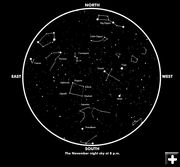Wyoming Skies for November
A monthly look at the night skies of Wyoming
by Ron Canterna, professor in the University of Wyoming Department of Physics and Astronomy
October 30, 2006
Say goodbye to the summer triangle by following the nightly setting of Vega, Deneb and Altair. November ushers in our beautiful winter constellations which rise around 9 p.m.
The Milky Way rides across the sky directly overhead and settles on the western horizon while accompanying the summer triangle. Overhead are two prominent constellations, Pegasus and Cassiopeia. Pegasus, the winged horse, is slightly to the south of the Milky Way, and is recognized by its famous Great Square. The queen Cassiopeia is easily recognized by its stretched out "W" or "M" star pattern.
Rising prominently in the east, a definite sign of the arrival of winter, is Taurus the bull, followed by Orion the hunter. Taurus, this majestic constellation, forms a prominent "V" in the sky and is the location of the nearest cluster of stars, the Hyades. Aldebaran is the bright orange star which forms the eye of the bull.
This November you will have a fine opportunity to view Saturn and its rings. It rises after 1 a.m., located in Leo the lion. You will not see Venus, Jupiter and Mars since they are all near the sun.
On Nov. 7, Mercury will transit the sun (see this month's interest story). Don't forget the Leonid meteor shower Nov. 17, it could be a great show since the moon is in a new phase.
November 2006 Interest: Transits and Eclipses
The planets lie in a very narrow plane while they orbit the sun. One time or another they all will pass directly behind the sun but only two planets, Mercury and Venus, actually pass in front of the sun, which is called a transit.
You can actually see Mercury's 10 arc-second diameter dark spot move across the sun's disk. Obviously a special telescope with a solar filter is needed. When the moon passes in front of the sun it is a solar eclipse.
Transits of Mercury and Venus are rare since you have to have an exact alignment of the three celestial bodies in a perfect straight line. On the average we have 13 transits of Mercury per century. Venus offers two transits per century and those are normally eight years apart. The next transit of Mercury will be May 2016. The last transit of Venus was in 2004, its next transit is 2012, followed by one a century later, in 2117!
See the NASA site http://sunearth.gsfc.nasa.gov/eclipse/transit/transit.html for more information on transits, solar eclipses and lunar eclipses.
You can get more details on the evening skies and a monthly star chart via the Wyoming Skies home page (http://wyoskies.uwyo.edu) or send an e-mail to canterna@uwyo.edu.
|
